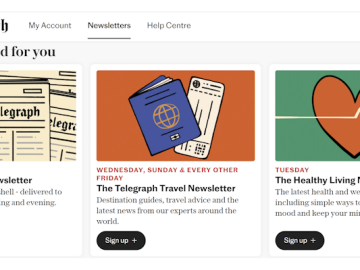How Do Successful Businesses Foster Collaboration Among Teams?
Imagine transforming your team’s collaboration with groundbreaking approaches from the minds of influential founders and top CEOs. This blog post gathers remarkable insights from industry leaders, featuring transformative tools and techniques to foster team synergy. Kickstarting the discussion is a strategy emphasizing the use of Slack, while the final pointer highlights the effectiveness of harnessing Discord for remote team enhancement, among eighteen total insights. Dive into this compilation to revolutionize teamwork in your organization.
- Encourage Collaboration with Slack
- Enhance Teamwork with Google Workspace
- Streamline Projects with ClickUp
- Innovate with Design-Thinking Workshops
- Foster Ideas with Mentimeter
- Organize Tasks with Basecamp
- Visualize Projects with Miro
- Manage Code with GitHub
- Customize Workflows with Monday.com
- Collaborate Visually with Trello
- Coordinate Efforts with Interdisciplinary Meetings
- Share Insights with Asana
- Enhance Remote Collaboration with Teamwork
- Align Teams with Notion
- Leverage Tools for Open Communication
- Streamline Communication with Zoho Cliq
- Integrate KPIs for Team Collaboration
- Enhance Remote Teams with Discord
Encourage Collaboration with Slack
Working in an industry where trends sometimes change overnight, Slack has become a major tool in encouraging collaboration. A lot of people think Slack is just another messaging platform, but internally, it has been molded into a rich FHA of brainstorming ideas, sharing insights, and creating synergy within diverse teams.
One standout example occurred during a major campaign launch for a high-profile client. Our creative, analytics, and social media teams were traditionally siloed, leading to fragmented strategies. However, using Slack’s channels, we brought everyone into the conversation early. This seamless communication allowed us to integrate insights from each department—designers incorporated data-driven suggestions from analysts, while the social team aligned content with creative visuals in real-time.
Andrew Juma, Founder and CEO, The AJ Center
Enhance Teamwork with Google Workspace
We rely on Google Workspace to enhance teamwork and productivity. Tools like Google Docs, Sheets, and Slides allow our teams to work on projects at the same time, regardless of where they are. This real-time collaboration means we can quickly share ideas, make live edits, and stay aligned without the back-and-forth of endless emails.
A great example of this in action was during the development of our new product line. We used Google Docs to create and edit product descriptions collaboratively. Our design team worked on creating visuals in Google Slides, while the marketing team crafted campaign strategies in Google Sheets. Constant live updates ensured everyone stayed on the same page, helping us launch the line ahead of schedule.
To get the most out of Google Workspace, it’s important to set clear guidelines on document sharing and editing. Ensuring every team member understands how to track changes and notify the group about updates can prevent confusion and streamline the workflow. This not only fosters a sense of collective ownership but also boosts efficiency, enhancing the chances of project success.
Connor Butterworth, CEO & Owner, Southwestern Rugs Depot
Streamline Projects with ClickUp
We use ClickUp to streamline collaboration among teams. This tool allows us to manage projects efficiently by integrating tasks, timelines, and goals into one platform. An example of successful collaboration facilitated by ClickUp was during a recent product-development project. By sharing real-time updates and feedback, our marketing, development, and customer-support teams could synchronize efforts seamlessly.
This coordination led to the timely launch of a new feature, which quickly increased user satisfaction and engagement. ClickUp’s flexibility in adjusting workflows to suit our needs played a key role in aligning team objectives and achieving a collective goal.
Valentin Radu, CEO & Founder, Blogger, Speaker, Podcaster, Omniconvert
Innovate with Design-Thinking Workshops
Design-thinking workshops are at the heart of our collaborative approach. Bringing together stakeholders from various teams, these workshops create a space for diverse perspectives to come together and co-create innovative solutions. By engaging everyone from engineers to marketers, we ensure every angle of a problem is explored, which helps us arrive at the best possible solutions quickly and efficiently.
One of our most notable successes came from a workshop aimed at refining our onboarding process. Together, we identified pain points and brainstormed potential solutions. The collective effort led to the creation of our personalized onboarding tutorial videos, which drastically reduced customer inquiries and improved user satisfaction. The insights gathered from different departments ensured the solution was comprehensive and user-friendly.
Encouraging open dialogue during these workshops is crucial. Facilitate sessions where everyone can voice their ideas without fear of judgment. Using structured brainstorming techniques, like “Crazy Eights,” can help generate a wide range of ideas quickly. These steps not only foster creativity but also build a sense of ownership among team members, driving collective success.
Mary Tung, Founder & CEO, Lido.app
Foster Ideas with Mentimeter
Mentimeter is invaluable for fostering collaboration in team meetings and creative problem-solving sessions. While most collaboration tools focus on task management, Mentimeter brings a dynamic and interactive element to brainstorming and idea-sharing. Its unique ability to gather live input from everyone—whether in the office or remotely—makes it an excellent option for generating and refining ideas collectively. We use the tool in our quarterly strategy meetings, where each department contributes ideas for improving customer deliverability and optimizing our email performance.
For instance, when preparing to roll out a new feature, we use Mentimeter during a brainstorming session with our tech and customer-success teams. We utilize word clouds, live polls, and ranking tools to ensure that everyone voices their thoughts on potential challenges and solutions in a structured manner. This approach helps us identify the most impactful features and prioritize updates based on real-time feedback.
Vladislav Podolyako, Founder and CEO, Folderly
Organize Tasks with Basecamp
We use Basecamp for teamwork and communication. We love it because it is highly visual and structured. Instead of guessing at your workflows or how you should collaborate with your team, Basecamp provides different modules to guide your collaboration efforts. It offers different tools for tracking projects, tasks, deadlines, discussions, files, and announcements about work. The centralized structure of the platform allows everyone to stay aligned on projects, ensuring no details fall through the cracks.
One example of how Basecamp contributed to our success was during a rebranding campaign for one of our e-commerce clients. The project required input from the design, content, analytics, and client relations teams. We relied on the platform to create to-do lists for each department, assign tasks to team members with clear deadlines, and maintain constant communication within specific project threads. This clarity ensured that everyone was on the same page, which helped us complete the project ahead of schedule.
Patrick McDermott, CMO, Max Cash
Visualize Projects with Miro
Miro is an online whiteboard platform that allows us to engage in real-time brainstorming, planning, and project visualization. To us, Miro is much more than just a brainstorming tool. Our teams use it to map out workflows, wireframe projects, and develop complex marketing strategies through a shared, interactive canvas. A good example of its effectiveness was seen during the launch of a large-scale e-commerce campaign for one of our clients in the fashion industry.
Our marketing and creative teams collaborated successfully on Miro to create a detailed marketing campaign roadmap, including ad concepts, timelines, and customer journey maps. Everyone had a chance to contribute in real-time on one platform, which reduced miscommunications and led to faster decisions. The result was a highly-coordinated Google and Facebook marketing campaign that led to a 16% decrease in cost-per-click and a 58% increase in website conversion rate during the launch phase.
Dan Ben-Nun, Founder, Growify
Manage Code with GitHub
GitHub is our go-to tool for code review, project management, and version control. The platform allows our development team to work on their code locally and then upload and share it with their teammates in real time. The version-control feature allows multiple team members to work simultaneously on different aspects of the same project while maintaining a traceable history of changes. We love this feature because it reduces the risk of errors and conflicts.
GitHub was instrumental in our workflow while developing our new AI-powered analytics platform. Our development team spanned different time zones and specialties. We used pull requests and code reviews to ensure that every change was thoroughly scrutinized, which was crucial to reducing bugs before deploying. The built-in discussion boards and issue-tracking also allowed us to quickly address roadblocks, share new ideas, and develop creative solutions.
Mitchell Cookson, Co-Founder, AI Tools
Customize Workflows with Monday.com
My business fosters collaboration primarily through Monday.com, an online project management platform, which is integrated with our internal tools and APIs. The platform allows team members to customize workflows, assign tasks, track progress, and collaborate on shared projects in real-time.
For example, when developing our SaaS platform, the team utilized Monday.com to break down the project into phases such as UI/UX design, back-end development, API integrations, and testing. Each team member was assigned tasks based on their expertise, and progress was tracked through the dashboard. This transparency allowed us to address issues faster and ensure everyone was on the same page, leading to the successful launch of features like the Email Authentication and Content Tester.
By integrating our tools into this collaborative environment, the platform helped streamline communication and coordination, which was crucial for launching on schedule.
Henry Timmes, CEO, Campaign Cleaner
Collaborate Visually with Trello
Our business relies heavily on Trello—a versatile project-management tool—to foster collaboration among teams. Trello enables us to organize tasks visually using boards, lists, and cards, where we can assign responsibilities, set deadlines, and track progress in real time. Its user-friendly interface makes it easy for teams across different departments to collaborate, share updates, and maintain transparency, even when working remotely or across different time zones. The platform’s ability to integrate with other tools like Slack and Google Drive further enhances our team’s ability to stay connected and productive.
A great example of how Trello has helped foster collaboration was during a critical software update. The project required close coordination between our development, marketing, and customer-support teams. Each department had its own set of tasks, but by using a shared Trello board, everyone could monitor the progress of other teams, offer insights, and quickly adapt to changes. The seamless communication and alignment between departments helped us launch the update on time and ensured that the marketing campaign and customer-support initiatives were ready to support the new release. This collaborative effort led to a smooth rollout, positive customer feedback, and an overall boost in user engagement with the updated software.
Sarah Lasaracina, CIO, AlfredHospitalityAI.com
Coordinate Efforts with Interdisciplinary Meetings
We use regular interdisciplinary meetings in which therapists, facilitators, and medical professionals share insights and coordinate efforts. These meetings create a collaborative space for team members to discuss client progress, share best practices, and align on treatment protocols.
A key example of this collaborative effort leading to success occurred during the development of our initial client-care program. Our therapists offered valuable insights on mental health, while our medical professionals focused on ensuring the physical safety of clients during sessions. By collaborating in these regular discussions, we designed a program that balanced emotional and physical well-being, which has since become a cornerstone of our service.
The program has received positive client feedback, praising the thoroughness of care and the personalized experience. This success highlights the power of collaboration across different disciplines, helping us provide an experience that is both effective and deeply supportive for those embarking on a psilocybin journey.
Gabe Charalambides, Founder, Odyssey
Share Insights with Asana
We use Asana, a powerful internal project-management and communication tool that enables all our teams to collaborate, from our data analysts to our account managers.
In addition to sharing real-time information, it facilitates brainstorming sessions and ensures that every member of each team has access to the most recent client information and celebrity insights. For example, if one of our data analysts comes across a social-media influencer who is a perfect brand fit for a client, they can post a quick note on the platform, tagging the account manager who is going after that specific brand. This provides the account manager with a shortcut, enabling them to reach out sooner to connect the right celebrity to the right brand. The collaborative system ensures that we’re quickly identifying the right spokesperson for our clients, and we’re able to connect them in a more efficient manner.
A major sports-apparel brand wanted to promote their upcoming back-to-school campaign with a celebrity athlete. The analysts used the platform to understand the athlete’s social media presence, content, and relevance to young athletes. They also identified the athlete’s off-court life—their personal philanthropies and brands that they currently endorse. The account manager received all of this information and was then able to prepare a proposal that best suited the campaign objectives of the brand—based on real data points.
Carmen Mendoza, Account Executive, Booking Agent Info
Enhance Remote Collaboration with Teamwork
We’ve implemented Teamwork as our primary project-management tool, which has significantly enhanced our remote-team collaboration. The platform’s user-friendly interface enables efficient task-tracking and project-progress monitoring, crucial for our marketing operations. It has notably improved communication and productivity among team members, leading to more streamlined campaign executions and better client outcomes.
While Teamwork has been invaluable for our agency, it’s important to consider potential drawbacks. The software’s complexity can present a learning curve for new users, and its occasional performance issues with data-heavy projects may impact workflow. Additionally, smaller agencies or startups might find the pricing steep. When selecting a project-management tool, carefully weigh these factors against your team’s specific needs and resources to ensure the best fit for your organization.
Aaron Whittaker, VP of Demand Generation & Marketing, Thrive Digital Marketing Agency
Align Teams with Notion
In our agency, collaboration thrives on a mix of clear communication and leveraging the right tools. We’ve implemented Notion as our central hub, which has been a game-changer for keeping everyone aligned. It allows all departments to track progress, share updates, and contribute ideas seamlessly. Everyone’s input is visible, ensuring that no voice gets lost in the noise.
One instance where collaboration really paid off was when we were tasked with a massive e-commerce overhaul. Our marketing, design, and development teams worked closely through Notion, laying out the customer journey, wireframes, and technical specs in one cohesive plan. The transparency allowed every team member to give real-time feedback and solve issues early on, which saved us countless hours and delivered a polished product ahead of the client’s expectations. It was a true all-hands-on-deck moment, and Notion helped make that level of synergy possible.
Harmanjit Singh, Founder & CEO, Website Design Brampton
Leverage Tools for Open Communication
I have almost two decades of cybersecurity experience and have been working in leadership roles for just as long. When you’ve been in the business for as long as I have, you come to understand that collaboration and communication are at the heart of business success.
We don’t use any unique tools to improve our communication processes, but the key to our success is how we leverage our tools and processes. We rely on Slack, Confluence, Google Suite, and Lucid to keep things running smoothly, but what really drives results is open communication and transparency across all levels of the organization.
This collaborative culture has been a game-changer in terms of innovation, meaning that we can uncover potential “gotchas” sooner rather than later. A diverse team comes with diverse perspectives, which means we can test ideas quickly—allowing us to innovate on solutions that matter. With an approach like this, we can deliver end results that are more refined, innovative, and that better solve the pain points of our consumers.
Seth Geftic, Vice President Product Marketing, Huntress
Streamline Communication with Zoho Cliq
For our internal team communication, we primarily use Zoho Cliq. It’s a great platform that offers a range of features for effective collaboration, including instant messaging, file sharing, channel creation, video conferencing, and task management.
This centralized hub helps us streamline communication and ensures everyone is on the same page.
One recent success story, where Zoho Cliq played a pivotal role, was during the development of our latest product feature.
The design, engineering, and marketing teams used the platform to share mock-ups, discuss requirements, and track progress in real-time. This open and transparent communication led to a smoother development process and resulted in a product that exceeded our expectations.
Alisha Pandey, UI/UX designer and product designing head, Tenet
Integrate KPIs for Team Collaboration
We emphasize the power of collaboration by integrating combined Key Performance Indicators (KPIs) across teams. This means that the success of one employee directly contributes to the goals of another, fostering a culture of teamwork and shared responsibility. By aligning individual KPIs with broader team objectives, we create a synergistic environment where every team member is motivated not only by their personal progress but also by the collective success of the company.
We also set team-wide goals that encourage cross-department collaboration. For instance, a recent example of this is the joint effort between our Sales, PR, and Content teams. By working closely together, they successfully executed a campaign that not only ran seamlessly but also resulted in acquiring several high-ticket clients. The combined expertise and collaboration between these departments were critical to the campaign’s success, demonstrating how teamwork accelerates growth for both our clients and our company.
Ultimately, our approach strengthens communication, accountability, and performance, leading to both individual and collective success.
Sahil Sachdeva, CEO & Founder, Level Up PR
Enhance Remote Teams with Discord
At our company, we’ve implemented Discord as a key tool to enhance collaboration, particularly for remote teams. The platform stands out because of its versatility in maintaining real-time communication. One of its most valuable features is the ability to quickly connect via audio channels, which closely mimics in-person interactions. This spontaneity fosters a more natural and continuous flow of communication, reducing the delays typical of formal messaging systems like email. It has helped maintain a connected atmosphere even when teams are physically apart.
A great example of how Discord has driven success is during a recent product launch, where various departments—design, marketing, and development—worked across different time zones. Through Discord’s instant voice chats and screen-sharing capabilities, we were able to host impromptu brainstorming sessions and resolve technical issues in real-time. This flexibility not only sped up decision-making but also strengthened team bonding, as people could collaborate more fluidly without needing to schedule formal meetings. Ultimately, this continuous, interactive engagement contributed to delivering the project ahead of schedule.
By using Discord, our team has been able to sustain high levels of interaction and collaboration, making it a cornerstone of our remote-work culture.
Vaibhav Kamble, CEO, CloudOptimo
Related Articles





